Beefsteak Fungus
By Mike on Monday, August 19, 2013, 20:53 - Permalink
 I've been keeping an eye out for Beefsteak Fungus for quite a long time now - and on a brief camping trip to Somerset, I found an almost perfect specimen.
I've been keeping an eye out for Beefsteak Fungus for quite a long time now - and on a brief camping trip to Somerset, I found an almost perfect specimen.
Later, I found more of them in the New Forest.
Identification Of Wild Fungi
The description here is not intended to be sufficient for conclusive identification of these wild fungi - the reader should understand that the possible outcomes of misadventure with wild-gathered fungi include serious illness and death.IT IS YOUR OWN RESPONSIBILITY to take adequate steps in identifying any fungi you gather for the table - doubly so if you are intending to share them with someone else.
Informal descriptions, such as the one on this page, are not adequate for full identification - it's just good sense to fully and independently verify everything you read here.
Rules of thumb or folk wisdom identification methods are frequently unreliable.
Consult a comprehensive identification guide (I recommend Roger's Mushrooms (site no longer available - see here) and Wild Mushrooms Online) or best of all, talk to a living human expert mycologist.
What Is Beefsteak Fungus?

Fistulina hepatica - a fungus forming softly rubbery lobe-like brackets up to 25cm across - predominantly occurring on oak or sweet chestnut in the UK - the brackets are rough and brick red on top; the underside is creamy coloured and composed of many tiny pores.
Said to resemble meat, this is further reinforced by the blood-red liquid that is exuded when the fruiting body is cut or broken.
Edibility is better in younger specimens.
Infection by this parasitic fungus imparts a rich, dark colour to the timber of oak trees - the resulting 'brown oak' is highly prized by woodturners and cabinet makers.

Excuses, Excuses - Or, Why I Didn't Eat It...
I was delighted to find this fungus, but unfortunately, not quite in a position to be able to sample it as food - for more or less the following reasons:
- Firstly, I was not absolutely 100% certain of its identity. I have a rule (you could say I - quite literally - live by it) - I don't eat any wild fungus until and unless I know for sure what it is. Fungi aren't the only thing in the world where misadventure can lead to mishap - so in fact, I apply the rule to other things too.
Anyway, I didn't have any of my mushroom books with me and I was in a place with no access to mobile internet - so this was an opportunity to make observations only.
It did in fact turn out to be exactly what I thought it was, but I wasn't certain enough at the time. - Nextly, we were not returning to camp to cook that day - so even if I had picked the fungus and later managed to ID it, we had no facility to keep it fresh until later.
- Finally (and this is a bit lame) - we didn't have any butter - I brought a frying pan and small stove on this trip, but forgot oil or butter. We could have bought some somewhere on the way back to camp, but the other two reasons above made it a bit pointless.
So... Live and learn - at least I have now learned to identify this fungus unaided - and next time I will be ready...
Like Or Dislike
Opinions are divided on whether this is an excellent edible fungus or a complete waste of time - some people have described Beefsteak Fungus as unbearably sour or tough (I wonder if they picked specimens past their prime), but most of my wild food resources describe this one as good or excellent.
Update - September 2014
Last time I found Beefsteak Fungus (which was also the first time I found it), I wasn't able to collect it.
On a foraging walk in the New Forest in September 2014, I found a nice young specimen - and this time, I took it home and cooked it.
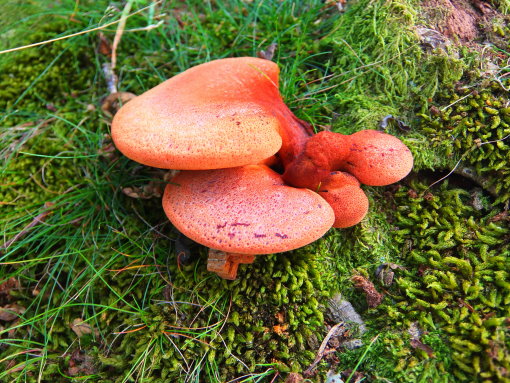
A Closer Look
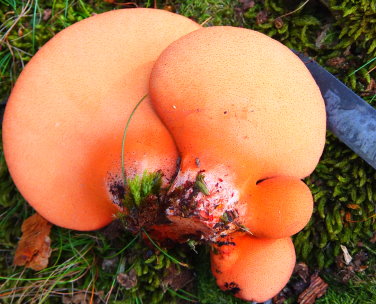 The specimen I found was quite young, comprising a cluster of fruiting bodies at the base of an oak tree.
The specimen I found was quite young, comprising a cluster of fruiting bodies at the base of an oak tree.
I cut if free with my pocket knife and it immediately started to exude blood-red liquid from the cut stalk.
The fruiting body is surprisingly heavy and solid-feeling for a mushroom - and it's easy to see why this thing bears such a meaty name - the top surface is red-brown and mottled; the underside is a sort of creamy skin colour - a mass of tiny sponge-like pores.
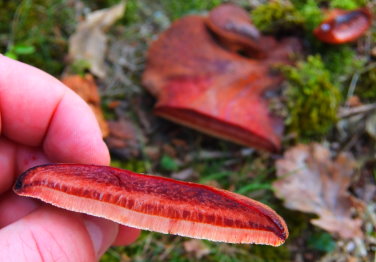 There was also an older specimen growing on the same tree - I sliced a piece off to take a look at it (and to help me absolutely verify the identity of what I was picking).
There was also an older specimen growing on the same tree - I sliced a piece off to take a look at it (and to help me absolutely verify the identity of what I was picking).
It really does look like a piece of steak when cut.
In The Kitchen
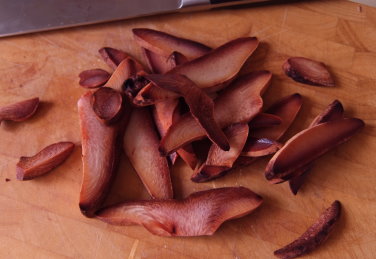 Beefsteak Fungus slices very easily and cleanly, and the juicy, cut pieces look very meaty and substantial.
Beefsteak Fungus slices very easily and cleanly, and the juicy, cut pieces look very meaty and substantial.
I decided to cook it to a recipe named 'Butter Boiled Beefsteak' - as recommended by Roger Phillips in his book Wild Food.
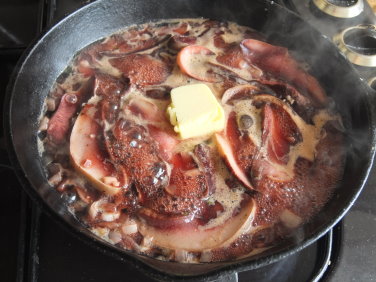 The recipe comprises simmering the sliced fungus with chopped shallots, garlic, thyme and black pepper in a little water, then reducing it down with butter until the liquid thickens almost to a gravy-like consistency.
The recipe comprises simmering the sliced fungus with chopped shallots, garlic, thyme and black pepper in a little water, then reducing it down with butter until the liquid thickens almost to a gravy-like consistency.
The appearance and smell were quite promising - mushroomy and mild. I dished it up onto a slice of toast (my go-to serving method for mushrooms, especially if there is juice or sauce to mop up).
 The flavour was OK - not especially distinctive, although there was a tiny trace of bitterness. The texture, I didn't really like - too floppy and gelatinous - and at the same time, oddly crisp and crunchy.
The flavour was OK - not especially distinctive, although there was a tiny trace of bitterness. The texture, I didn't really like - too floppy and gelatinous - and at the same time, oddly crisp and crunchy.
I'm glad I finally got to satisfy my curiosity about this wild food, but it's not one I'll be in a hurry to try again.
